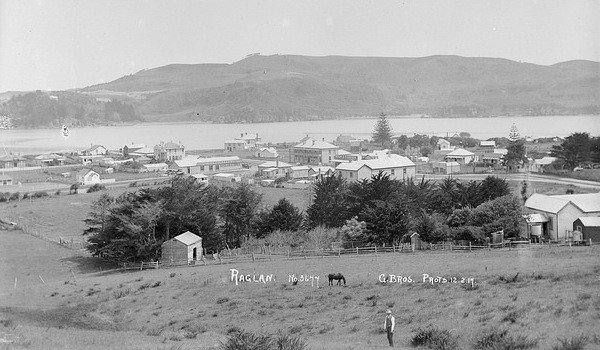Sands of time – Continuing our occasional history series, we look back to Whaingaroa a century ago – 1917
by John Lawson
A century ago, the Great War, which had been expected to be over by Christmas 1914, was still in stalemate at the start of 1917 and conscription by lottery was increasing. In 1917 three Raglan Whaingaroa soldiers were killed at Ypres, another nearby and two wounded. For those who weren’t men aged 20 to 45, anxiously reading the monthly ballot lists, there were less stressful problems, such as the state of the roads.
Background 1 Wi Neera St, Anglican church, Farmers store, Post Office, Gilmour Bros Raglan Stores, Royal Hotel, bakery, Langley’s store (The Shack), Harbour View Hotel, Moon & Cameron’s store, Old timber Town Hall, Frank Bray’s butchers.
Photo by Gilmour Brothers (Firm). Raglan, 1917 – Photograph taken by Gilmour Brothers. Published by Price, William Archer, 1866-1948 :Collection of post card negatives. Ref: 1/2-001019-G. Alexander Turnbull Library, Wellington, New Zealand.
Raglan’s population at the October 1916 census was only 217, but 56 in the Raglan port area were eligible for service. Among them was Raglan’s vicar, Rev. Seton, one of five clergymen drawn in a late 1916 ballot, sent to France as Anglican chaplain to the 28th Reinforcements in July 1917 and returned in 1919.
About a third of conscripts appealed against service. Union leaders who spoke against conscription were jailed for sedition and recruits who tried to get away were pursued. One such was James Malins, who was reported as, “rather well known in this district, having been resident here some time before being called to take part in the defence of his King and country”. In October 1916 he was one of 59 who passed the medical test. After training at Featherston, he was given final home leave, but didn’t return to camp. In September 1917, “two constables, armed with a good service revolver each” chased him at a logging camp near Waingaro. By November he was on a ship arriving at Liverpool on 7 January 1918 and the next report of him was being wounded in August 1918, eventually arriving at Auckland in April 1919.
Meanwhile his bush contractor employers were fined £50 for employing a deserter. That was quite a lot, for in August the old Raglan Agricultural & Pastoral Association showground (now Bankart St – the area behind the bushes in the photo above) was sold for £31 (2016 equivalent $3,700). The show had moved in March to Kauroa’s new saleyards, linked by motor cars with Raglan.
For another comparison, Raglan Co-operative Dairy advertised for a manager for their dairy on Wallis St, as a “new up to date butter factory, with a manager’s residence on the harbor front. The output is about 100 tons of butter, and the salary, £225 per annum” (about $26,000 today), though it also came with house and allowances.
In earlier years some were so eager to enlist, they had sold their farms to join the Expeditionary Force, but, by 1917, to encourage more volunteers, and provide for conscripts and more family men, the Raglan Efficiency Board was set up to manage soldiers’ farms. Massey, often known as “Farmer Bill”, was Prime Minister during the war. This may have influenced the setting up of the limeworks, after which Limeworks Loop Rd is named. Despite other shortages and restrictions, a Leicester company was allowed “to manufacture and export to the British Dominions iron and steel machinery to a limited extent during the war period so as not to lose touch with its agents and customers overseas”. The report also said, “A notable feature of the plant is that it is entirely automatic, requiring, apart from the quarry work, only two men—a feeder and a bagger.”
